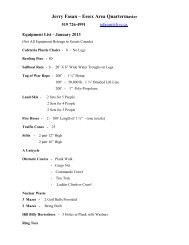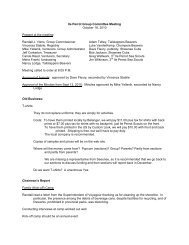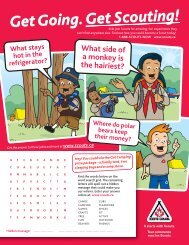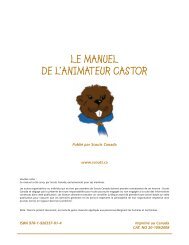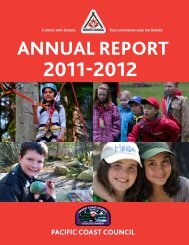Beaver Leader's Handbook - Scouts Canada
Beaver Leader's Handbook - Scouts Canada
Beaver Leader's Handbook - Scouts Canada
Create successful ePaper yourself
Turn your PDF publications into a flip-book with our unique Google optimized e-Paper software.
ELEMENTS TO THEMES<br />
The <strong>Beaver</strong> program has seven program elements: games, crafts, music, storytelling, playacting,<br />
spiritual fellowship and outdoors. Chapters 13 to 17 treat these elements in detail.<br />
Use these elements to create specific theme programs.<br />
Many leadership teams find programming is easier when they use theme ideas. For example, you<br />
might use Outer Space as the focus for a series of meetings which includes films, stories, crafts,<br />
special guests, a play, space puppets, outdoor games and songs.<br />
In this way, you can give your <strong>Beaver</strong>s new educational information while you help immerse their<br />
imaginations in a space environment. Similarly, themes based on seasons, occupations, historical<br />
times, safety or the community can become vibrant and exciting, given careful programming.<br />
Theme planning provides direction and a framework upon which you can build an exciting wellrounded<br />
program. It also makes a leader’s job easier because members of the team can keep an<br />
eye open for ideas long before they present the theme to the <strong>Beaver</strong>s.<br />
USING THEMES<br />
One way you can use themes is to set up a colony project in which<br />
different tail groups work separately. Each group contributes to the<br />
project by doing age-appropriate activities which, when pooled<br />
together, complete the total project.<br />
A simple example might involve making posters promoting a western “round up” night.<br />
Leaders select or draw pictures; Brown Tails colour them; Blue Tails cut them out; and White<br />
Tails compose the posters by pasting the pictures onto bristol board.<br />
You might organize a month’s activities around different themes: migration, hibernation, getting<br />
ready for winter, fitness (set up a fitness trail and have everyone do five to 10 minutes of<br />
exercise at each meeting), senses, or pets (include a visit to the local Humane Society).<br />
Try to ensure that all theme programs are well balanced to include the seven elements. Set up<br />
a parent roster that arranges to have one parent at each meeting. It means a great deal to the<br />
<strong>Beaver</strong>s, develops parents’ interest in the <strong>Beaver</strong> program, and gives you some extra help.<br />
DEVELOPING THEMES<br />
One program planning method many colonies use involves developing an entire colony meeting<br />
or series of meetings around a central idea. This doesn’t necessarily mean a special festive<br />
theme such as Halloween, but almost any other idea you can develop with a little imagination.<br />
Let’s look at how to develop a simple idea into a program – the theme idea of food, for example.<br />
Sit down with other colony leaders and list as many things related to food as you can think<br />
of. Brainstorm. Let the ideas flow without stopping to accept, reject or discuss their merits.<br />
Here’s the kind of list you might end up with: candy, macaroni, crackers, nutrition, growing,<br />
cooking, beans, beanstalk, golden eggs (can you see a story idea emerging?), peanuts. That’s<br />
only a short list that one person thought up in a few minutes. You can do much better when<br />
you share the experience with others.<br />
9-1



